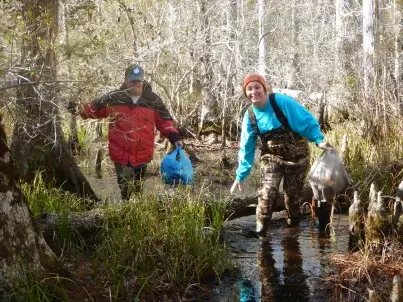Featured Data
Monthly Litterfall, Monthly Tree Band, and Annual Tree Growth of a South Carolina Coastal Wetland Forest
September 1, 2019
Susanne Grossman-Clarke
Citation
Conner W. H. 2019. Monthly litterfall, monthly tree band, and annual tree growth of a South Carolina coastal wetland forest. Environmental Data Initiative. https://doi.org/10.6073/pasta/87e25c8383eb7f857f38fe532e408775. Dataset accessed 9/05/2019.
Description
This data package has been published with the support of Vanessa Bailey, EDI’s Summer 2019 Fellow at the Baruch Institute of Coastal Ecology and Forest Science.

In the southern United States, forested wetlands are of special interest because of the extent of these forests. One of the problems in developing management practices for these areas is the difficulty in adequately describing productivity relations and predicting how the structure and function of these communities might be affected by natural or anthropogenic disturbances. Community response to environmental change often occurs over a period of years, and the majority of reported studies are for 1–3 years in duration. This study was initiated in an attempt to examine long-term changes in forest systems in response to drought, flooding, hurricanes, and climate change. This study documents long-term changes in structure, composition, and growth along a gradient of high water table forested sites of an ancient beach ridge landscape in coastal South Carolina. Permanent study plots (20-m x 25-m) were established across a moisture gradient (Xeric, Mesic, and Hydric – 5 plots in each) within a longleaf pine-swamp blackgum forest system on the southern end of the Waccamaw Neck area of Georgetown County, SC in January 2000. Litterfall was measured monthly using five 0.25 m2 litter traps in each plot beginning in February to December (Fig. 1a). Monthly circumference change was recorded on a subset of trees within each plot using stainless steel dendrometer bands. Diameter of all trees greater than or equal to 10 cm diameter at breast height in each plot was recorded annually at the end of the growing season (Fig. 1b).

References
Busbee, W.S., Conner, W.H., Allen, D.M., Lanham, J.D. 2003. Composition and Aboveground Productivity of Three Seasonally Flooded Depressional Forested Wetlands in Coastal South Carolina. Southeastern Naturalist, 2(3), 335-34. https://doi.org/10.1656/1528-7092(2003)002[0335:CAAPOT]2.0.CO;2
Conner, W.H., Song, S., Williams, T.M., Vernon, J.T. . 2019. Long-term tree productivity of a South Carolina coastal plain forest across a hydrology gradient, Journal of Plant Ecology, 4(1-2), 67–76. https://doi.org/10.1093/jpe/rtq036